Three flights to Havana from Miami: who knew?
Flights to Cuba. I’d been to Cuba 10 years earlier with a rugby team on a Treasury Department license, but we flew from Nassau, and after all was said and done, I wish we’d done the same this time. What a hassle!
There is a regular (several times per week) charter flight from Miami to Havana, operated by American Airlines. Because we went with the charter company for the flight, we figured we’d do the hotel with them as well. Because of the embargo, it’s a lot easier to do business with a company licensed by the Treasury Department. Unfortunately ABC Charters has a limited selection of hotels with which it does business and we ended up with a hotel that was more expensive than we’d counted on.The Hotel Sevilla turned out to be a very nice
place.
At any rate, Richard, Taylor, Chip, Heide and I got to the airport at about 7:30 AM, or more than 4 hours before departure. There were at least 50 people ahead of us on line and the line just got longer and longer. Most people had their bags wrapped in plastic, no doubt fearing theft.
Toni caught a 5:45 AM flight from Chicago and her timing was kind of hairy - her flight didn’t get in till nearly 10 AM and she had to leave security (which she hadn’t realized) – but our contact at the charter company passed her off as a diplomat and got her to the front of the line and, as they say, all’s well that ends well. The rest of the trip – until we got through
immigration in Cuba – was pretty uneventful.
No! No! Not our
passports!
We got through immigration and were heading to a
security X-ray prior to baggage claim when a Cuban official (in a
mask presumably to show how they were vigilant about the H1N1 flu
but more likely just to be pains in the butt to the people flying
in from the US [and only the important people wore them, probably
to hide their facial expressions from us – it was all so
bizarre]) took my passport. I looked at
Heide and hers had been taken too.
“We’ll give them back to you on the other side (of
security)” she said to Heide but there was no sight of her
when we got through.
There was just one baggage carousel in a small area
and Cuban officials just threw the bags off the belt on top of one
another. This was not the kind of
treatment we’d gotten on any of our previous trips, but it
was also the first time we’d been on any of the direct
flights from the US.
Our bags took about an hour to get
there (that is,
all of the bags for the seven of us – among other things we
had to keep looking for them among and under all the bags on the
floor). While we waited Heide went to
the masked lady and asked why we were being questioned.
Oh, just a routine interview, she
said. When we got our bags, the woman
under the mask kept quizzing us; then Richard showed up and asked
if we were ok. She asked if he was with
us. “My brother,” I said,
and she just gave us back our passports. Way to go,
Richard ... (whatever you did) ...
So strange.
Note to
self: remember this when I think of returning on a direct
flight.
Niurka, the Havanatur rep, gave us
a bunch of stuff
that ABC Charters had forgotten. And
she found us a cab. We had not been
able to change money so we organized two cabs for US$30 each (US
dollars are no longer legal tender in Cuba but in a pinch
they’re acceptable). But before
we got to the cabs we had to just about push our way through a huge
crowd lining the walk outside the terminal building waiting eagerly
to see their US family – some with signs for relatives
they’d never seen before. It was very emotional but we were
in such shock none of us took any pictures.
51 Years of Revolution! Upon leaving
the
airport, we see the roads covered with billboards praising the
revolution and condemning Yankee imperialism; they diminish in
number as we get into town and we never were able to get enough
photographs to represent them well. The sign below is one of
the gentle ones. And of course the omnipresent 1950s US cars were,
well, omnipresent.

We were supposed to get into Havana about 1 PM; not only were we delayed in Miami but the entire airport hassle delayed us again and it was after 4:30 by the time we got to the hotel.
Richard joins the Mafia. If you’re acquainted with the history of Cuba, you know that one of the reasons for the revolution was the corruption which successive Cuban governments shared with the Mafia, who were allowed free rein in their country. By the time of Batista’s second stint as president, it was all too much. One of the stories of the Hotel Sevilla is that Al
Capone famously rented the entire sixth floor.
Richard is actually staying in Capone’s
room, 615, commemorated by a plaque just outside the
door.
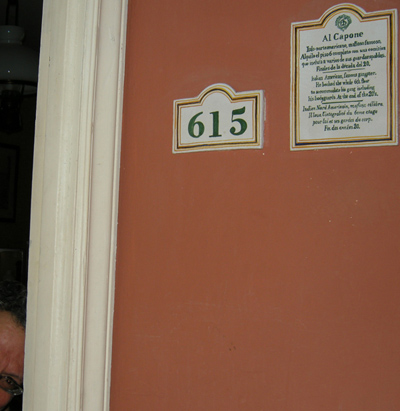
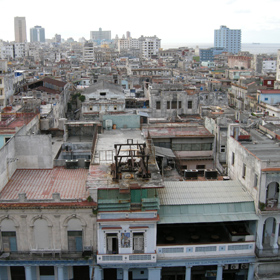
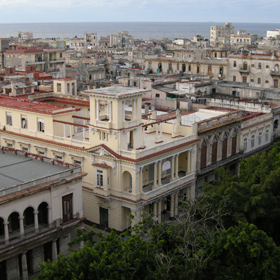
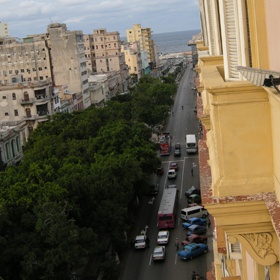
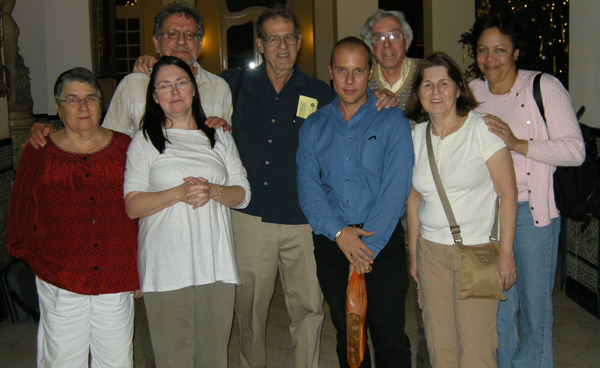
The reason I had brought euros, by
the way, is that
Cuba imposes a 10% fee on US Dollars.
Thus the posted rate at the CADECA was 89 cents on the CUC. With
the 10% fee we were only able to get 80 centavos on the peso
convertible for a dollar. Again, on the
street one can supposedly avoid this fee, but – again –
we chose to just go the legal and safe route.
By the way, although dollars are
not allowed to
circulate, Cubans who get them are able to trade them in for pesos
so if that’s all you have in your pocket, you can usually
survive.
At this point we realized that none
of us had eaten
at all all day long (!) and José took us to a restaurant
– Viejo Amigo - in the Barrio Chino (Chinatown).
There was a long line (not too uncommon in Cuba)
and we were asked if we were “el último” (the
last in line, a staple phrase of the “Cuban line
culture” which I discussed in an article on our 1999 trip to
Cuba).
The ethics of the line are, you
find "el último" and make sure that person knows you are
behind him or her. At that point, you can go about your business,
returning occasionally to check the status of the line. Of
course, if the person in front of you gets served before you
return, you lose your place in line and have to start
again.
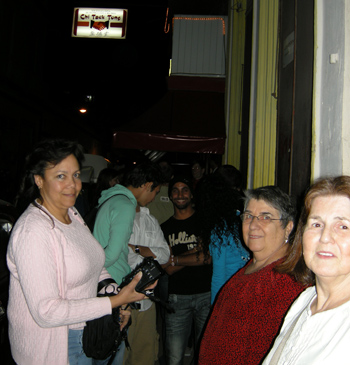
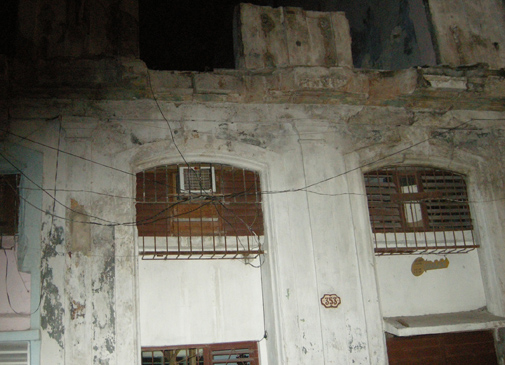
Left:
On
line
at
Viejo
Amigo
(Chi
Tack
Tong)
in the Barrio Chino (Chinatown)
Right: View from the Queue
As we stood on the line, we were looking across the street at the shell of a building which had obviously been a nice place many years ago but was now just an abandoned shell. These buildings are just way too common in Havana.
The food was great (there were some Chinese items on the menu, but it was basically generic Cuban), and the portions HUGE. And the price way lower than what you’d find anywhere other than places that Cubans frequent – about $5.00 for a meal. Still, even at those prices, it’s about 1/3 of what the average Cuban makes in a month. Chippie restrained herself from ordering pizza,
which was on the menu (“Wouldn’t it have been
something,” she said, “to go to Cuba, then to
Chinatown, and order a pizza!”)
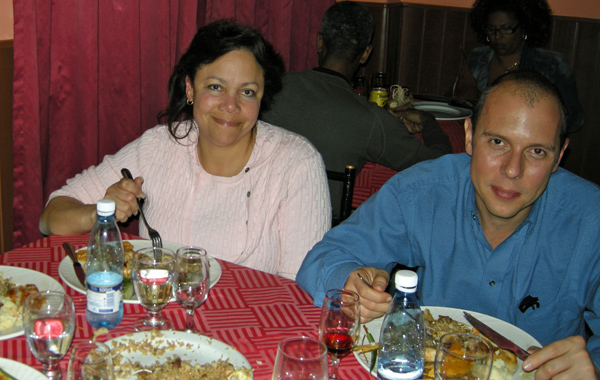
José Antonio negotiated us a ride
back in
a
1957 Chevy, who took 4 of us back to the hotel, then the other
four. Then it took him back
home. When the car started to pull away
with us in it, I wasn’t sure it would make it past the first
sputter. But it got us to the hotel,
and José home, considerably farther.
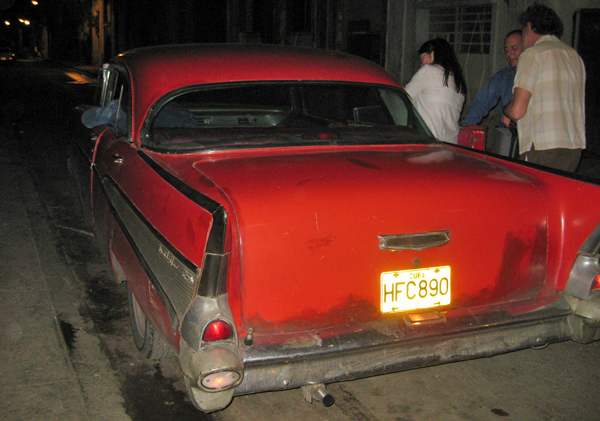
I commanded Richard to
stick around at the
hotel for a very nice Havana Club Añejo Reserva rum, and he,
Chippie and I had a nightcap prior to ending a very, very long day.
Añejo Reserva or Añejo 7 Años (one level
higher) would be our final drink each evening.
Breakfast at the Hotel Sevilla. Breakfast is included in the hotel price ($178 per day per double room - that's normally way out of my affordable range!) and served from 7 to 10 AM. We’d had a long day (and were to have long days for the rest of the trip) and met at 9 AM for breakfast. It was decent and filling: fruit, pastry, eggs, meat, and of course coffee, tea and juice, in other words, the equivalent of a good American breakfast.
Proof of our ancestry: Iglesia de Monserrate. We walked from the hotel down the beautiful Prado, then down Neptuno towards our destination. Chippie continues to comment – correctly – that it is obvious that this city was once quite a place, these buildings architectural beauties. But there is decay all around us as we walk.
We continue on to Galiano (AKA Avenida de Italia), make a right and a block later, at the corner of Galiano and Concordia, we reach our goal.
At this corner is located the “Iglesia de
Monserrate”: the church of Monserrate. It
was in this building, 100 years ago (plus two
weeks) where our grandparents – Antonio LAGOS TOLEDO and
Josefa BESTEIRO GRACIANI, whom we knew as “Papa” and
“Maina”, were married. It was our intention to acquaint
ourselves with the church and then I planned to try to find someone
that might help us find out if their marriage certificate was still
around.
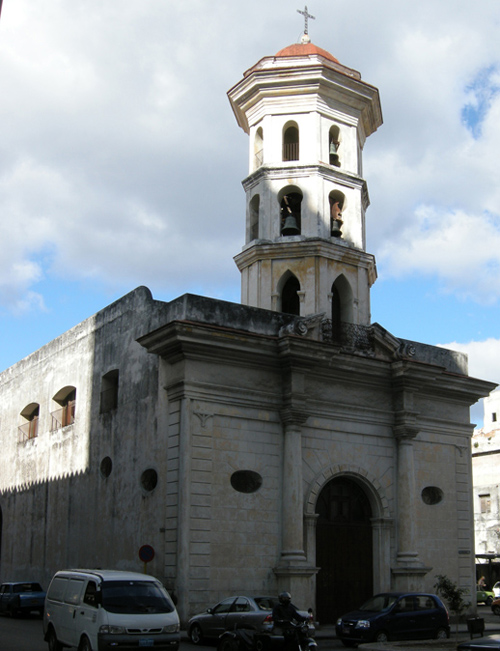
Raul Ballate. We took
pictures
from the outside, then from the inside.
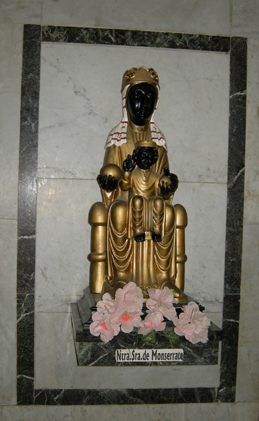
While we were doing this, I saw a man in the back of the church who looked curious about our activities. I explained that we were the grandchildren of a couple that had been married there 100 years ago. Out of the blue he said, “Would you be interested in seeing their marriage certificate?”
I was stunned. “Si, si … claro,” I said. It turns out Raul Ballate has been
with the church
of Monserrate for 40 of his 47 years, beginning – I assume as
an altar boy – at the age of seven. He
studied to be a priest, left to get married but
then returned, and is now studying to become a deacon.
He is also the church Archivist
(Archivero) and was
as enthusiastic about this job as I am in my self-appointed role as
family historian.
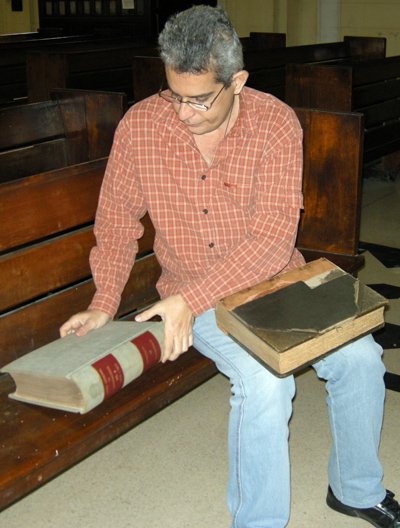
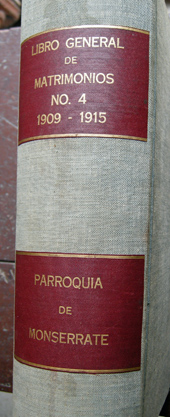
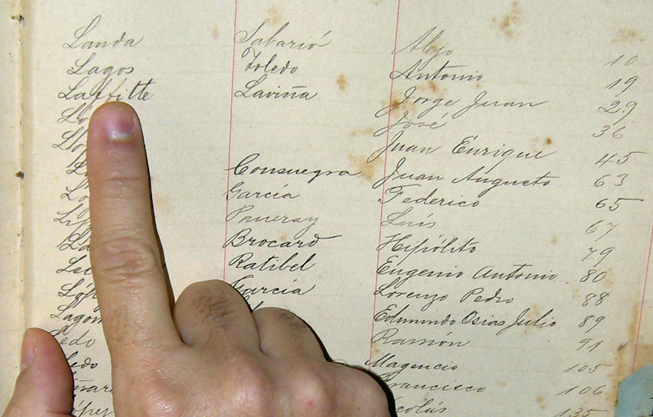
And there it was: the 100-year old wedding certificate of Antonio and Josefa. In order to maintain its readability I've included it as a link, rather than imbed it in this page.
Page 1 - Maina-Papa wedding
certificate
Page 2 - Maina-Papa wedding
certificate
Raul reads the entire certificate to us – even, I think, to those that didn’t understand the Spanish, it was a very moving event. The middle part of his reading can be heard by clicking on the link below.
Uncle Manuel and part of his weird story. To Richard and me, who knew the story I’m about to relate, it was particularly revealing, that is, a big surprise thrown in the middle.
The short backstory is that our grandfather’s
brother married our grandmother’s (widowed) mother, i.e. at
the time of our grandparents’ wedding, the groom’s
brother was married to the bride’s mother.
Thinking it would be unseemly for his younger brother to marry his [Manuel's] step-daughter (who was also the daughter of his [Antonio’s] sister-in-law), Manuel forbade Antonio to marry Pepita. The two lovers, unsurprisingly, ignored Manuel’s dictate. At least, this has always been the oral history.
The family story had been that Joaquina, an aunt who was to become famous as our Aunt Dee’s nanny, was present at the wedding in lieu of the bride’s mother and, in response to Manuel’s question to her on the evening of the wedding “Where were you today,” responded “Where your wife would have been if she had any guts!”
We find, however, in Raul’s reading of the marriage certificate that, indeed, Maina’s mother did not show up. In her stead as maid of honor, however ["en representación de Doña Victorina Graciani"], was not Joaquina, but Alejandrina CARO GRACIANI. (For Richard and me the period at the end of the last sentence should be an exclamation point.) Richard and I know that Alejandrina was a Spanish relative of our great-grandmother Victorina (we always thought a first cousin, but – I digress and do not elaborate – I have recently found she was really a niece – well, first cousin once removed, but let’s not get complicated about this stuff: in Spanish she is a niece). She was also a famous actress who was undoubtedly performing in Cuba at the time. The pieces fall in place for me because I was never able to place Joaquina in Cuba in 1909. It must have been Alejandrina that told Manuel off.
Later, reading the certificate in peace, I see that one of the witnesses was Ángel SALA LEYDA. Ángel is another well-known Spanish actor who was Alejandrina’s second husband. Wow!! (again, that wow! is for Richard and me; the rest of the party was undoubtedly and blissfully unaware of all this, as you, dear reader, I’m sure, wish you were as well).

Alejandrina Caro
and Ángel Sala at Maina and Papa's
wedding
On top of all this information, Raul was able to
find the “expediente” – the (supposedly
transitory) document or documents which provided the information on
the certificate itself – and we were able to photograph these
documents as well.
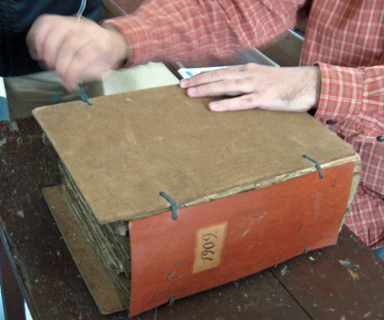
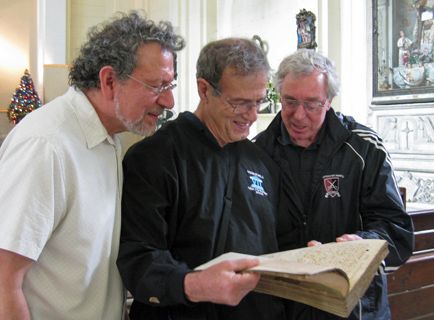
Left: Raul brings out collection
of expedientes from 1909.
Right: 3 of Maina and Papa's
grandchildren - Richard, Emil, Buzz - check it
out.
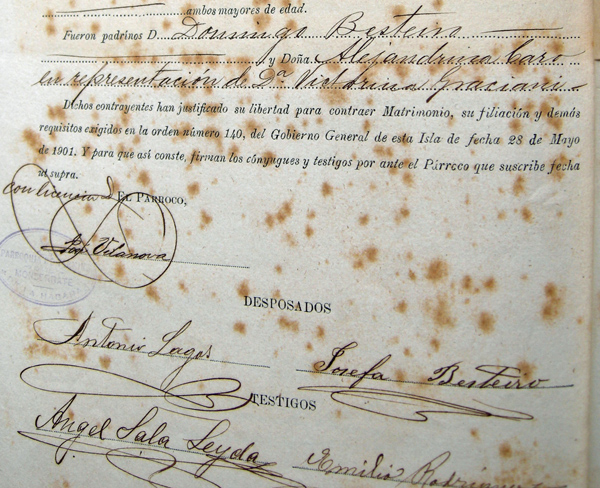
Aunt Vickie’s baptism – and (!) marriage. I knew that, for some odd reason, my mother, the oldest sibling, had not been baptized here, and that Uncle Manny, child #2, was born and baptized in Spain, but my data showed that Aunt Vickie, #3, was baptized here in 1912.
Raul goes through the index and indeed finds "Lagos – Besteiro – Victorina". He tracks down her baptismal certificate and – amazingly! – in the margin there is a comment that says “The person described in this certificate was married in the church of Saint Mary in Paterson, NJ with Raymond Joseph Goetz on the 18th of November 1944.” True dat.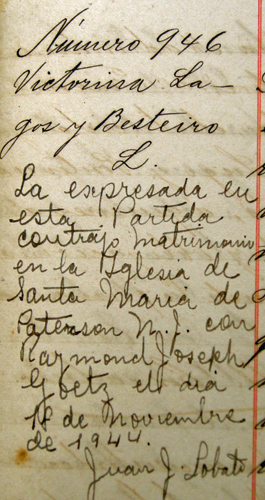
According to Raul, the laws of the Church require that
the parish
of marriage inform the parish of baptism.
Maybe, but I’ve only ever seen something
like this once before, more than a hundred years earlier in Italy
… It’s really a spectacular find!
What about Aunt Dee? After Aunt Vickie’s birth, the family moved to New York and didn’t move back for four more years, and it was here that Aunt Dee was born, on New Year’s Day 1917. We had no idea where she was baptized, but Raul was on a roll, and we asked him to check for her.
Amazingly (how often have I used this word in the last few paragraphs), we found her! Raul was reading down the index page with all of us looking over his shoulder, and about to turn the page, when Heide cried out “allí está – Lagos Besteiro.” Had she not noticed it, we would have concluded that she must have been baptized elsewhere. Chippie was in tears.
The entire baptismal certificate can be found
here: Aunt Dee's baptismal
certificate
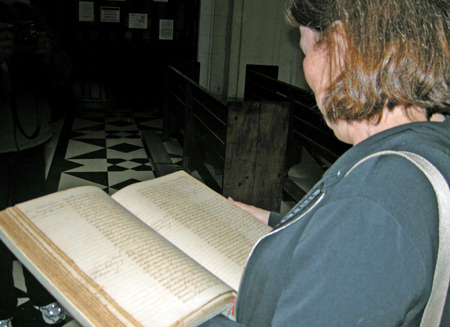
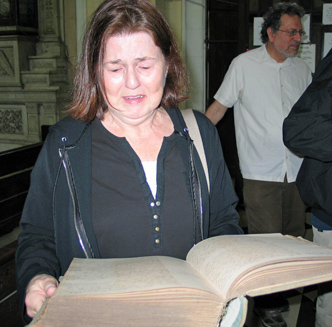
Raul then told us that it was possible that he also had the “expediente” for Aunt Dee’s baptism. The church was supposed to throw all these out 10 years after the event because this preliminary record of the facts actually needed for the baptismal records was no longer required. Raul, however – how I understand! – could not bear to part with all these records and, between the church and his house, had conserved them all. “How,” asked Heide, “does their storage impact your house?” “Ah,” said Raul, “that is something with which my wife has quite a problem.” Heide understood.
At any rate, Raul found the expediente for Aunt
Dee’s baptismal records, signed by our “Uncle
Dominic,” Domingo Besteiro Graciani. He
gave the original to Chippie to
hold. She was grateful, till he gave it
to her to keep, when she was amazed.
“No worries,” said Raul, “we were supposed to
throw this out in 1927.”
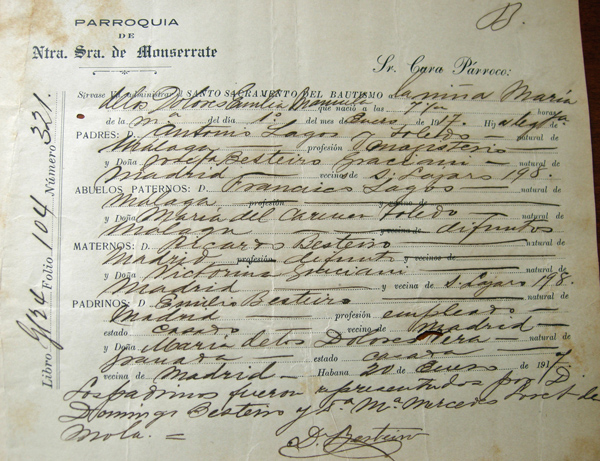
But it wasn’t there.
My mother’s birth address. It was well past lunch time, and we all headed back to the hotel. We walked down Galiano and passed #125, the house where my mother was born. Or at least she was born at this address; I continue to suspect the numbering may have changed in the last 100 years. [NOTE of March 5, 2010: on March 2, I finally found the numbering changes (they took place in 1938) that enabled me to determine the actual location of our family's dwellings - at some point in the future there will be a link from here to all that data. Interestingly, it is at the edge of the Barrio Chino. A picture follows.]
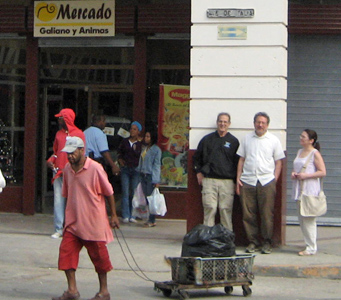
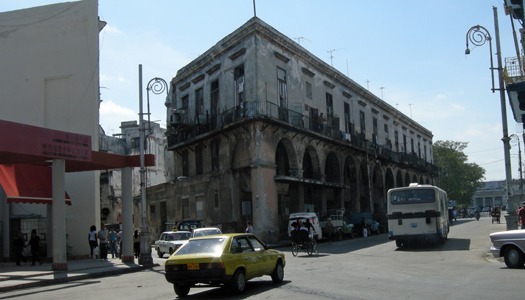
Left: Emil & Richard with
Taylor at the "wrong" Galiano address for their mother (the current
Galiano 125)
Right: two months later, Emilito found the correct location of his
mother's birth: it was at the corner of Galiano and Zanja.
Galiano is the street with the yellow car and Zanja the cross
street. The new number of Galiano 125 is Galiano 509.
If it was on "this side" of Zanja, the building no longer exists;
if on the other it may be the corner building.
The first number I found on that side was 513.

"This side" of Zanja on Galiano
& Zanja. This entire block now is set off by signs
indicating:
"Barrio Chino de la Habana" and "Oficina del Historiador de la
Ciudad"
This picture and the one above, right, were taken on March 2,
2010
We walked along the famous Malecón, the
seaside walk along the Straits of Florida; the Keys directly to our
left. We couldn’t walk on the
water side as it was a windy day and the water was smashing in to
the quite high sea wall and covering the sidewalk with water every
few seconds. And it was nearly record
cold in Havana: high in the low 60s.
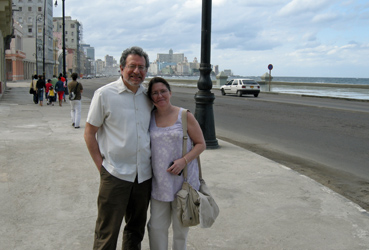
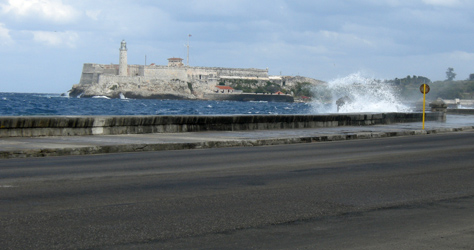
Left:
Richard
and
Taylor
on
the
Malecón
...
Right:
Water splashes on the sea wall; Morro
Castle in the background
Aunt Dee’s birth
address.
In the process, we go by what should have been the
addresses where the family was living when Aunt Dee was born
– San Lázaro 198. The
problem is, San Lázaro 202 is a corner building, and then a
street, a vacant lot, followed by San Lázaro
172. This is one of the reasons I
concluded 10 years ago that I felt there had been a global street
numbering change sometime in the past 100 years. [NOTE
of
March
5,
2010:
on
March
2
I
found the actual location of Aunt
Dee's birth, now San Lázaro 318. See
above.]
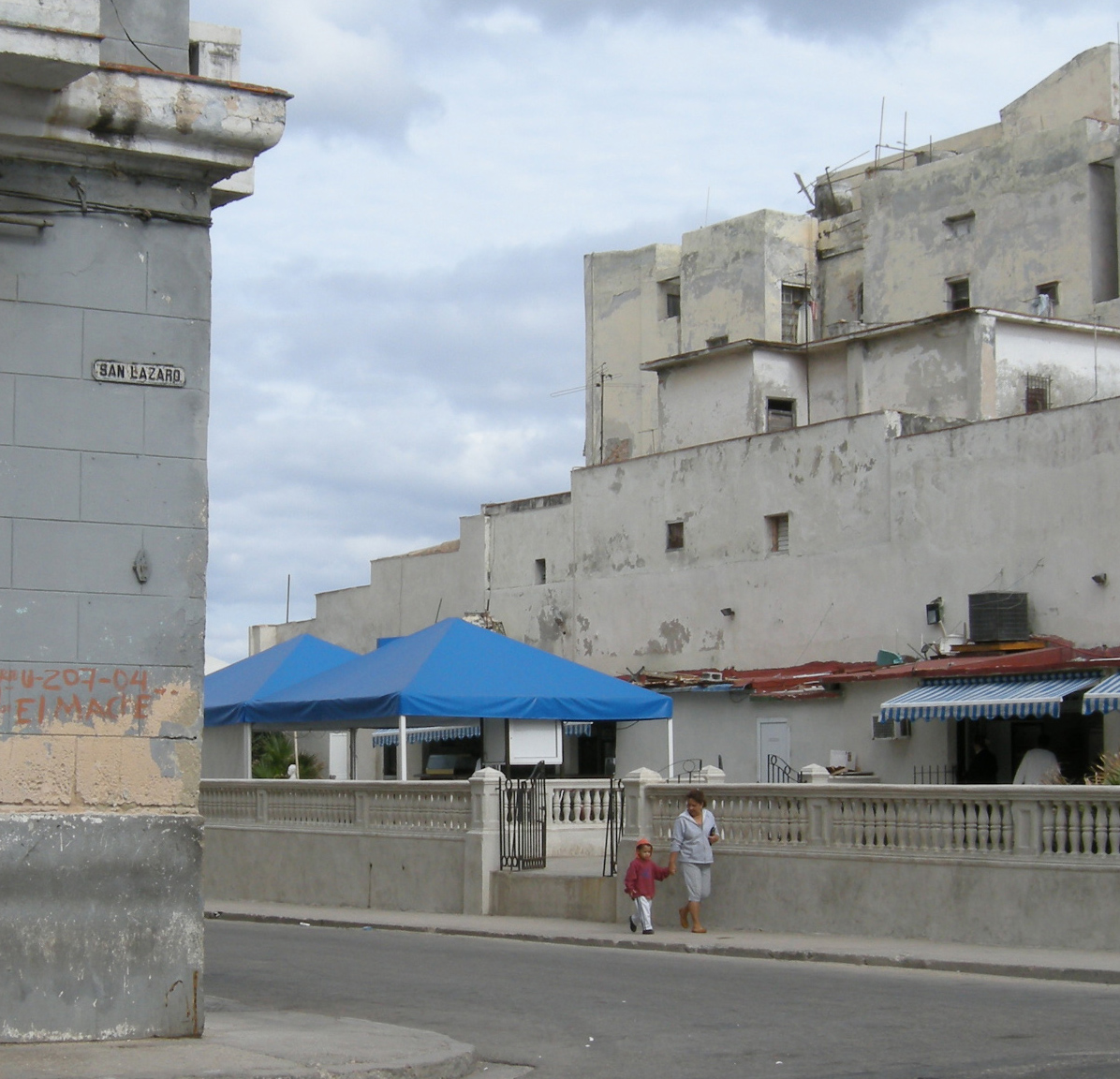
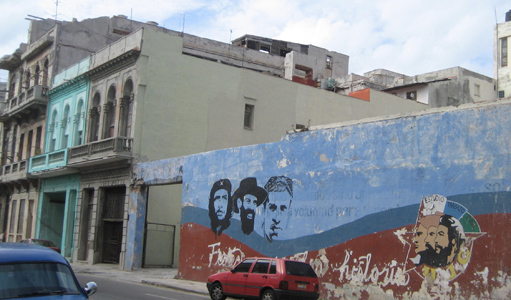
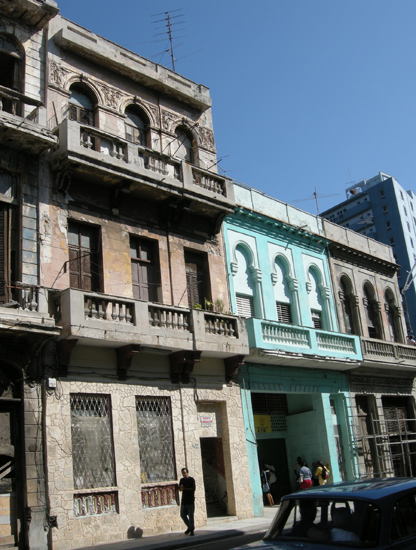
The house on
the left is Aunt Dee's birth house, now San Lázaro 318.
Picture taken March 2, 2010.
Winding our way through Centro Habana, through more
streets of decaying buildings, we got back to the hotel, where we
had a very late lunch of ham and cheese sandwiches.
There’s no rest for the weary, however; we had a full week (not to mention the rest of the day; it was barely past noon) ahead of us.
A re-visit with Diana.
The one
person that most everyone of my generation knows is Diana DENIS
GARCÍA (actually now she's officially VALDÉS-DENIS
GARCÍA, but that's another story), granddaughter of
Maina’s sister Isabel, whom we knew as Aunt
Betty. Diana visited us just prior to
the revolution and both Chippie and Buzzy, as well as Richard and
I, remembered her.
The last Heide and I had visited with Diana and her
husband Simón (who is president emeritus of the Cuban
B’nai Brith), they were living on the seventh floor of an
apartment whose elevator was normally out of order.
They are now in a second floor apartment that was
formerly their daughter (Dianita)’s.
Dianita married a Spaniard and is now in Madrid.
Although small, their apartment on G street in Vedado has a nice
open balcony.
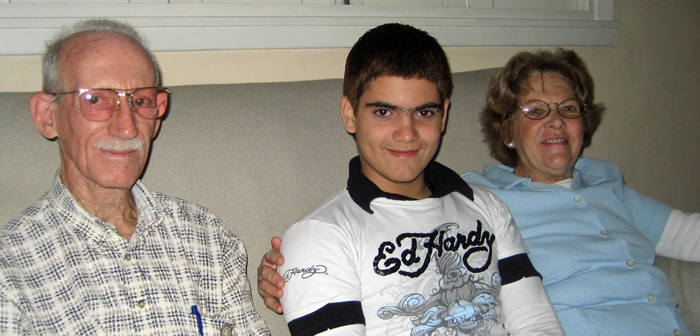
We have an enjoyable time with Diana, Simón, and their grandson Fernando, Dianita’s youngest son (interestingly, her oldest, named Fidel Castro, is now living in Miami).
Diana cracked up when she realized who Buzz was ("¡ah, Bosi!" she said ... "¡que majadero! (what a troublemaker!)" ... remembering Buzz's behavior as a youngster)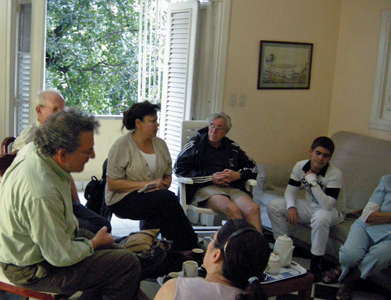
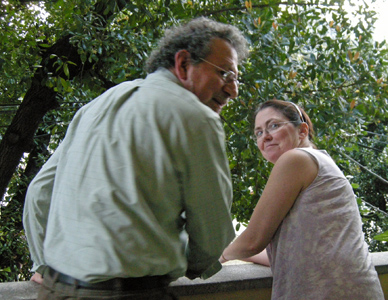
Fernando, 15, has access to a computer, but his
speakers are broken… We make a note.
We walk with Diana, Simón and Fernando to La Roca, a restaurant in Vedado (Calle M and 21?, I really should remember these addresses) with very huge portions, low prices (my meal was $3.50 and I couldn’t finish it); another restaurant that is known by Cubans. And, like Viejo Amigo, had a long line, seemingly a sign that it is well known. (The rooftop restaurant at the Seville, as a comparison, had entrees in the $20 plus range.)
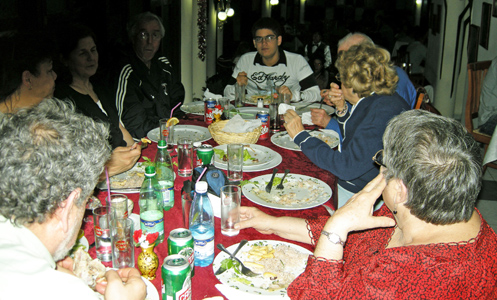
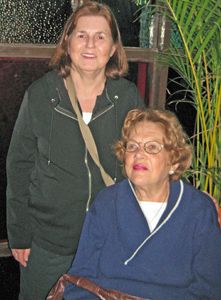
Left: Eating a big meal
at La Roca
Right: Chip and Diana as we prepare to leave La Roca
We got stuffed, walked back to the hotel, where we (we always included me, and usually Richard, Taylor and Chippie) had a nightcap – I just love that Havana Club añejo (I usually had the reserva) – and retired, looking forward to another busy day. It was hard to believe that this had been our first full day in Cuba.
I think we did something in the morning, but I have no notes. At best it was slow.
Baseball in Cuba. This is the first time I have been in Havana during baseball season and I really wanted to see a game, as did we all. Baseball games have been moved from nighttime to the day in order to conserve the electricity needed to light fields. We met José Antonio at 1 PM and headed to the smaller of the two Havana ground to see the lesser of two Havana teams, the Metropolitanos, play Matanzas, the next city to the east of Havana.
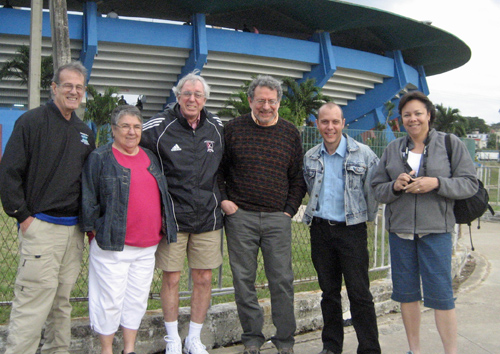
At the beisbol stadium for the
Metropolitanos game
Emilito-Heide-Buzz-Richard-José Antonio-Toni
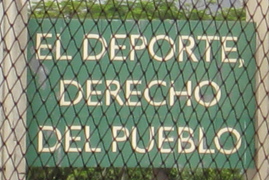
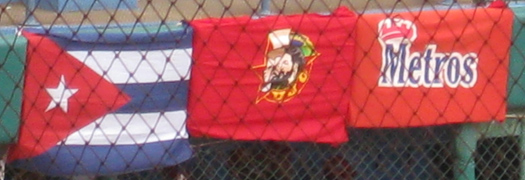
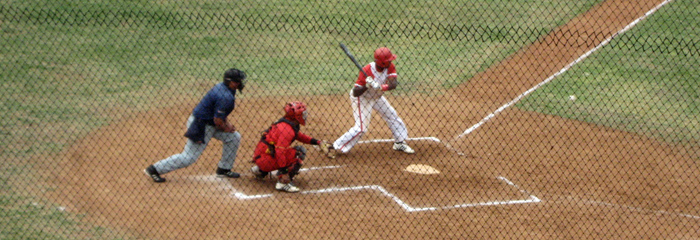
It wasn’t crowded (an understatement) but it was interesting. The food vendors were selling wasn’t the fanciest – pork rinds, candies on a stick, some pastries, but they were at Cuban prices – pennies. In the midst of this, however, Richard was able to find a Cuban with whom to compare iPhones.
I had been told by T-mobile that my phone would work in Cuba, but all I could get was an “SOS” signal – supposedly that I could call 911 (or possibly the Cuban equivalent?) … The guy Richard was talking with swapped SIM cards with him, and Richard was able to get coverage. Apparently we could have (should have?) bought SIM cards and paid a week’s cost – about $50 – to have cell coverage in Havana.
In addition, Richard decided to switch his camera to video just in time to get a Matanzas player smashing a monster home run (jonrón). The player, Yoandri Garlobo, has represented the Cuban national team. See the jonrón here.
By the time the 8th inning came around Matanzas was ahead 7-2 (over Chippie’s beloved “Mets”) and – as it was really cold (well, the records show it was probably low/mid 60s) – we reckoned we could leave. We later found out that the Metros tied the game in the 8th but lost in the 9th.
We grabbed a couple of cabs and went to José Antonio’s house in the Santos Suárez district of the city. There we met Isabelita, José Antonio’s mother, and, when she returned from work, José’s wife Magda.Isabelita is the daughter of Ricardo Mateo, well
known to many of the US family, and the granddaughter of Joaquina
Lorenzo, legendary as the nanny of Lolita AKA Aunt Dee,
Chippie’s mother. Joaquina is renowned in the Dee
branch of the family for having said to our Maina, after the birth
of Uncle Charlie, “Why did you bring him into the world? He
is bothering my Lolita.”
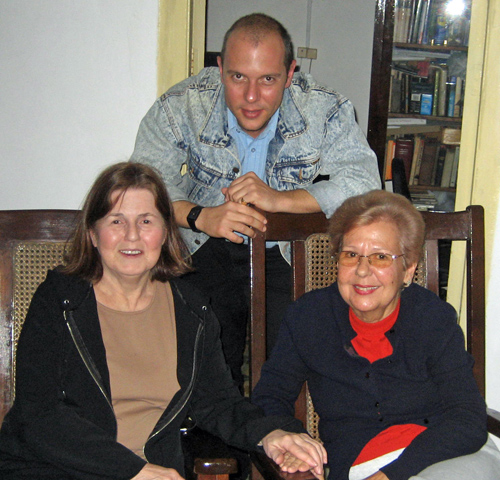
Chippie was fond of noting the decay of nice
buildings (or perhaps more accurately the nice buildings that must
have been before the decay), and this is certainly true in Santos
Suarez. José Antonio’s
house, however, was an exception as he has managed to do a
remarkable job of restoring it. And the
ceiling – my God, how high it was – 5 meters (16
feet)!! Remarkable.
Keep that heat rising and be cool and comfortable
below.
While waiting for Magda,  we partake of good
Cuban rum
and discuss family with Isabelita.
we partake of good
Cuban rum
and discuss family with Isabelita.
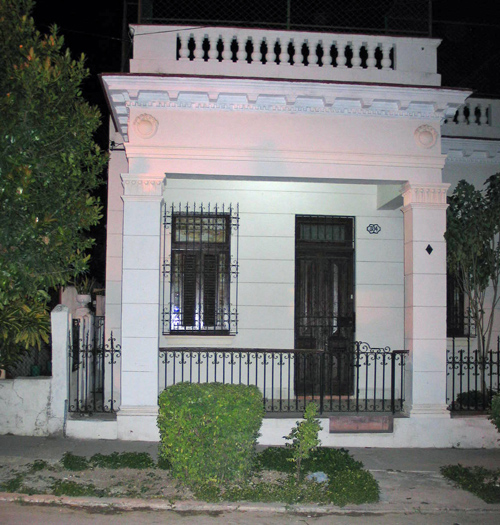
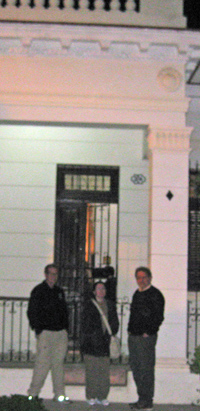
When Magda arrives, we head to yet another restaurant
with big
portions and low prices: Los Curros on Calle Santos
Suárez. I select ropa vieja, a good classic Cuban
meal.
I mention these places to Cubans later in the week, and they all know them, so I guess there’s a network of these high-value restaurants known to the Cubans all around town. Yeah, there was a line.
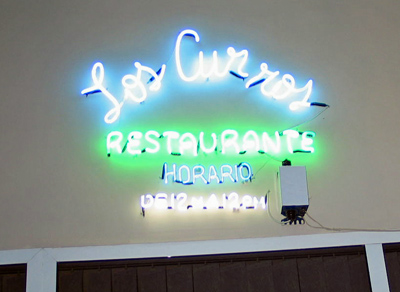
Los Curros restaurant on Calle
Santos Suárez
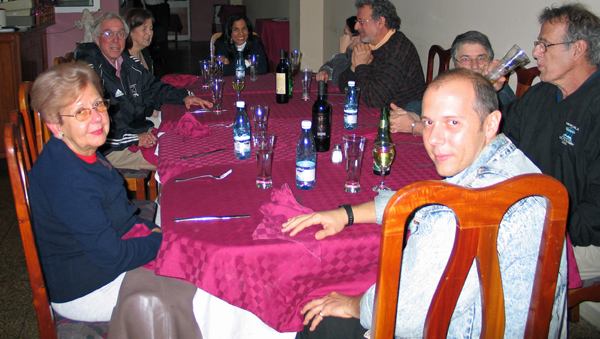
Having a
pre-dinner drink at Los Curros. José and Magda at the
ends;
Isabelita, Buzz and Chip on the left; Taylor, Richard, Heide, Emil
on the right. Toni was the camera person
José finds us a couple of cabs and we head
home. The usual: nightcaps and
sleep.